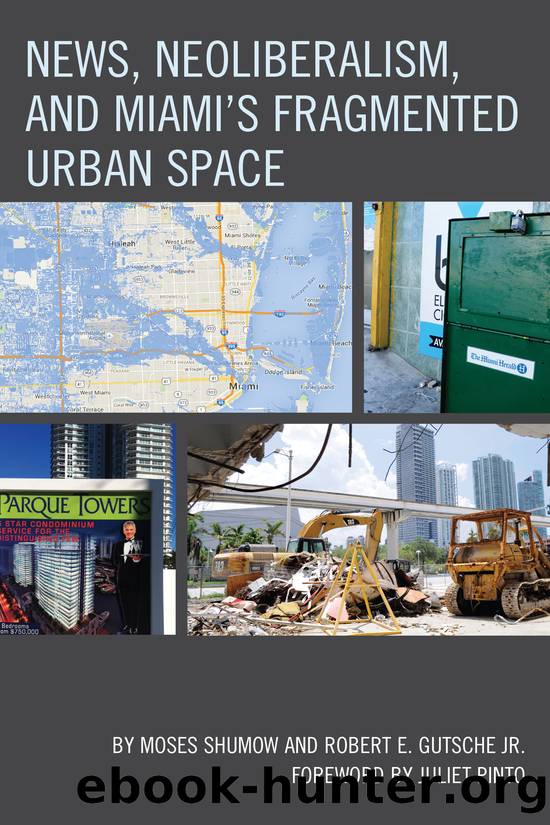News, Neoliberalism, and Miami's Fragmented Urban Space by Shumow Moses;Gutsche Robert E. Jr.;Pinto Juliet;

Author:Shumow, Moses;Gutsche, Robert E., Jr.;Pinto, Juliet;
Language: eng
Format: epub
Publisher: Lexington Books/Fortress Academic
Our goal is to contextualize arguments presented in earlier chapters within the digital age, making clear that as quickly as technology and society converge in online realms, those virtual spaces remain very much contested and connected to physical geographies as levels of access that communities have to high-speed Internet is very much related to where they are located and the demographics of their residents (Horrigan & Duggan, 2015). In turn, the ideologies of neoliberalism that refute and negate any solutions to inequality that are not market-based will also continue to transform and update in varied and rhizomatic forms (Peters, 2001), making the need for a project of (un)veiling of digital inequalities (Smith, 2015a, 2015b) all the more urgent.
For Liberty Square, this analysis comes at a particularly crucial moment. In early 2015, as South Floridaâs housing and construction market was once again moving into overdrive following the economic collapse of 2007 and 2008 (see Introduction), Miami-Dade Countyâs Department of Public Housing and Community Developmentâthe government entity that operates the housing projectâannounced that it had identified $70 million in local, state, and federal housing funds available for affordable housing projects and was requesting bids from private contractors for the ârazing and redevelopmentâ of Liberty Square (Smiley & Rabin, 2015).
As the bidding process got underway in 2015, and with the final construction costs estimated between $300 and $500 million, major developers with deep pockets, political connections, and experience in building affordable housing lined up. Nearly all of the developers seeking the job were also major donors to local politicians, while one had recently come under federal scrutiny, with charges of embezzlement, indictments and arrests in the previous year (Weaver, 2015). When the announcement came, media coverage of the plans for redevelopment, examined in this chapter, mostly heralded the idea for solving the problems of Miamiâs most ânotoriousâ (Zea, 2015) public housing project:
The mayorâs plan represents a sweeping change for tenants who often say they live in substandard conditions and in fear of gangsters and dope dealers who have terrorized their neighborhood with gunfire. A series of half-measures have failed for years, and now (Miami-Dade County Mayor) Gimenez wants to wipe the slate clean and start fresh. (Smiley, 2015a)
In a typical neoliberal narrative, solutions for social problems identified in the news could only be found in the building of shiny new condos, the enrichment of private builders through taxpayer dollars, and the redevelopment of public housing. It is a policy solution to urban poverty that has been repeated in similar attempts across the United States to address problems with where and how to house the poor (Vale, 2013): the removal of the people that live there. As of this writing, huge questions loom for Liberty Squareâs residents.
Who will be allowed to stay in Liberty Square?
Who will be forced out of the neighborhood as redevelopment gets underway?
What will the new housing mean for their neighborhood?
Will they have any say in the changes to come, as old apartments are torn down and new ones are built?
Download
This site does not store any files on its server. We only index and link to content provided by other sites. Please contact the content providers to delete copyright contents if any and email us, we'll remove relevant links or contents immediately.
The Secret History by Donna Tartt(18838)
The Social Justice Warrior Handbook by Lisa De Pasquale(12141)
Thirteen Reasons Why by Jay Asher(8790)
This Is How You Lose Her by Junot Diaz(6778)
Weapons of Math Destruction by Cathy O'Neil(6139)
Zero to One by Peter Thiel(5684)
Beartown by Fredrik Backman(5594)
The Myth of the Strong Leader by Archie Brown(5420)
The Fire Next Time by James Baldwin(5246)
How Democracies Die by Steven Levitsky & Daniel Ziblatt(5127)
Promise Me, Dad by Joe Biden(5087)
Stone's Rules by Roger Stone(5026)
100 Deadly Skills by Clint Emerson(4840)
A Higher Loyalty: Truth, Lies, and Leadership by James Comey(4840)
Rise and Kill First by Ronen Bergman(4701)
Secrecy World by Jake Bernstein(4639)
The David Icke Guide to the Global Conspiracy (and how to end it) by David Icke(4624)
The Farm by Tom Rob Smith(4434)
The Doomsday Machine by Daniel Ellsberg(4415)
